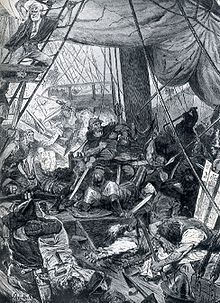
The Hanseatic League was a medieval commercial and defensive confederation of merchant guilds and market towns in Central and Northern Europe. Growing from a few North German towns in the late 12th century, the League between the 13th and 15th centuries ultimately encompassed nearly 200 settlements, across seven modern-day countries ranging from Estonia in the north and east to the Netherlands in the west and Kraków, Poland, in the south.
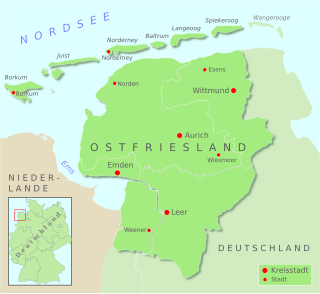
East Frisia or East Friesland is a historic region in the northwest of Lower Saxony, Germany. It is primarily located on the western half of the East Frisian peninsula, to the east of West Frisia and to the west of Landkreis Friesland.

The County of Holland was a state of the Holy Roman Empire and from 1433 part of the Burgundian Netherlands, from 1482 part of the Habsburg Netherlands and from 1581 onward the leading province of the Dutch Republic, of which it remained a part until the Batavian Revolution in 1795. The territory of the County of Holland corresponds roughly with the current provinces of North Holland and South Holland in the Netherlands.
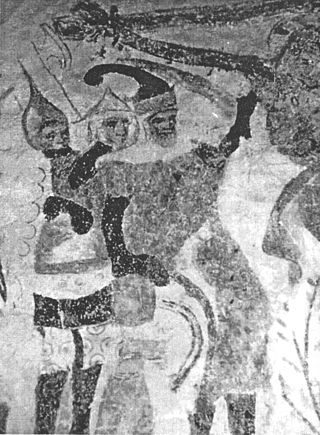
The Victual Brothers, Vitalien Brothers or Vitalian Brethren were a loosely organized guild of 14th century Germanic privateers that initially included Mecklenburg nobility, but that later became more thoroughly the efforts of commoners, and turned to outright piracy. The guild had a clear historical effect in that era on maritime trade in the North and Baltic Seas. As privateers, they provisioned blockaded locations and otherwise served as a naval contingent on behalf of regional rulers, with clients that included the Queen of Denmark, and rulers of Mecklenburg and East Frisia. As their activities turned to piracy, the aims devolved to personal enrichment.

"Nikolaus" Storzenbecher or "Klaus" Störtebeker was reputed to be leader of a group of privateers known as the Victual Brothers. The Victual Brothers were originally hired during a war between Denmark and Sweden to fight the Danish and supply the besieged Swedish capital Stockholm with provisions. After the end of the war, the Victual Brothers continued to capture merchant vessels for their own account and named themselves "Likedeelers". Recent studies manifest that Störtebeker was not called "Klaus" but "Johann".
Magister Wigbold , , also called “Master of the Seven Arts” was a German pirate who belonged to the famous Likedeeler pirates of Klaus Störtebeker who were active in the North and Baltic seas. Wigbold was one of the most noted Likedeeler, along with Gödeke Michels and Störtebeker. The nickname Wigbold comes from wig (strife) and bold. Whether Wigbold was a nickname, or possibly his real name, is unknown.
The Friso-Hollandic Wars, also called Frisian-Hollandic Wars, were a series of short medieval wars consisting of the attempts made by the counts of Holland to conquer the free Frisian territories, which lay to the north and east of their domain. These wars were waged off and on from 1256 to 1297, 1324 to 1348, 1396 to 1411, and from 1421 to 1422, although it could be argued that a state of war continued to exist between the County of Holland and the Frisian territories till well after the year 1500.

Hamburg was founded in the 9th century as a mission settlement to convert the Saxons. Since the Middle Ages, it has been an important trading center in Europe. The convenient location of the port and its independence as a city and state for centuries strengthened this position.

Cord Widderich was a pirate active during political conflicts between Dithmarschen and North Frisia in the early fifteenth century. He lived during the times of Klaus Störtebeker and the Victual Brothers, but was not part of their movement.

Built in 2000, the Hamburg Dungeon is a tourist attraction from a chain including the London Dungeon and Berlin Dungeon. It is the first of this brand to be built in mainland Europe. It provides a journey through Hamburg’s dark history in an actor led, interactive experience.

The Treaty of Utrecht was signed in 1474 after the Anglo-Hanseatic War between England and the Hanseatic League.
Hennig Wichmann was one of the leaders of the German Likedeelers, an association of former Victual Brothers who had turned pirate.

HafenCity is a quarter in the borough of Hamburg-Mitte, Hamburg, Germany, Europe. It is located on the Elbe river island Grasbrook, on the former Port of Hamburg area. It was formally established in 2008 and also includes the historical Speicherstadt area, which since 2015 is an UNESCO World Heritage Site with the adjacent Kontorhausviertel. The main landmark of the HafenCity is the Elbphilharmonie concert hall.

Frisian freedom was the absence of feudalism and serfdom in Frisia, the area that was originally inhabited by the Frisians. Historical Frisia included the modern provinces of Friesland and Groningen, and the area of West Friesland, in the Netherlands, and East Friesland in Germany. During the period of Frisian freedom the area did not have a sovereign lord who owned and administered the land. The freedom of the Frisians developed in the context of ongoing disputes over the rights of local nobility.

The Hanseaten is a collective term for the hierarchy group consisting of elite individuals and families of prestigious rank who constituted the ruling class of the free imperial city of Hamburg, conjointly with the equal First Families of the free imperial cities of Bremen and Lübeck. The members of these First Families were the persons in possession of hereditary grand burghership of these cities, including the mayors, the senators, joint diplomats and the senior pastors. Hanseaten refers specifically to the ruling families of Hamburg, Lübeck and Bremen, but more broadly, this group is also referred to as patricians along with similar social groups elsewhere in continental Europe.
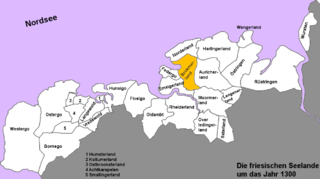
The Brokmerland is a landscape and an historic territory, located in western East Frisia, which covers the area in and around the present-day communities of Brookmerland and Südbrookmerland. The Brokmerland borders in the east on the Harlingerland and in the north on the Norderland. The historic Brokmerland is usually written with only one "o". Occasionally one also finds the spelling "Broekmerland", while today's communities have chosen to spell the name with a double "o".
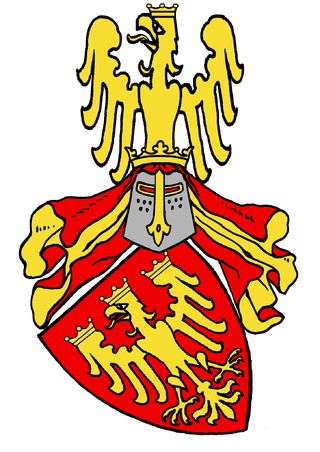
The tom Brok family were a powerful East Frisian line of chieftains, originally from the Norderland on the North Sea coast of Germany. From the second half of the 14th century, the tom Broks tried to gain control of East Frisia over the other chieftain families. The line of tom Brok died out in 1435.
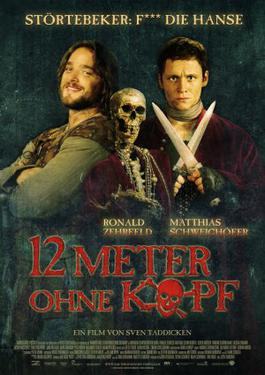
12 Paces Without a Head is a 2009 film set in the North Sea in 1401. The film centers on the German folk hero Klaus Störtebeker, who was a pirate at the time. The title comes from a legend which asserts that when he was captured by the Hanseatic League, he struck a deal with his captors that every one of his men whom he could walk past after being decapitated, would be let go. Störtebeker's body allegedly managed to make twelve paces before collapsing.
Johan van Valckenburgh was a Dutch military engineer who built fortresses. He is known for building the Bastion Henricus which was a fortification around Hamburg. Today the Hamburg History Museum is on this site.
